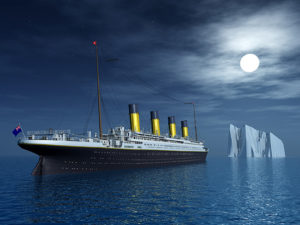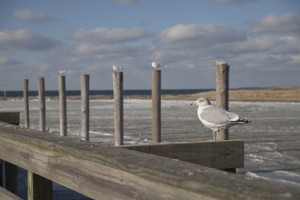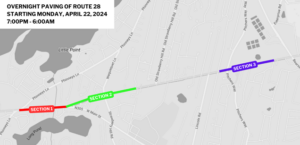A passenger liner making its way from Southampton, England toward New York has run into some trouble in the North Atlantic. It’s late at night, the details are fuzzy. They’ve hit something, an iceberg, and they’re taking on water. Things are not looking good for the ship and if any of the 2,240 passengers and crew on board are to survive then the HMS Titanic will need help quick.
Several hundred miles away in Wellfleet, on Cape Cod, was the Marconi Wireless station. They took in communications from ships traversing the Atlantic and provided news updates from New York each evening at 10:30 est.
It was for this reason that a wireless operator aboard the ocean liner Carpathia happened to be tuned into Cape Cod’s transmissions.
21-year-old Harold Thomas Cottam was off-duty, headed to bed for some rest, but wanted to catch up on the latest news concerning a coal strike back home in England. He figured that the person manning the station on Cape would have it and so he was listening. This was the first in a series of fortuitous events for the Titanic on a night that was otherwise most unfortunate.
As he listens, Howard hears that the Marconi Station on Cape has a number of transmissions for the Titanic but that they aren’t getting through. Howard, who was apparently quite the sport, had heard earlier in the day the Titanic’s own wireless operator was loaded down with work on this particular evening and, out of sympathy for the poor guy, decided to help out all involved. He decided to take down the messages and relay them to Titanic himself in the morning.
“As I was the nearest station to the Titanic, it was more or less my duty to retransmit them to him.” Howard told the New York Times following the sinking.
Howard sits down at his communications machinery, to relay the Titanic, let them know about the transmissions and about his intention to make contact in the morning. He puts in is headphones and connects to the ship. Titanic answers.
“I asked him if he was aware that a batch of messages were being transmitted for him via Cape Cod,” he recalled to the Times.
“Come at once,” Is the reply, “We have struck a berg.”
In shock, Howard asks if it is serious, the Titanic responds that it is very serious, gives their position, and tells Howard to get the Carpathia there as soon as possible.
Our hero spends the next several hours waking the captain and officers to alert them to Titanic’s predicament. It apparently takes some convincing, the Titanic being “unsinkable” and all that. Plus wireless communication was a fairly new technology, Carpathia’s crew was skeptical this must be an error, but better safe than sorry. They turn around and make way to help.
From his communications room he radios the Titanic’s S.O.S. call to other ships in the area, notably the Frankfort and the Olympic. All the while he keeps communication open with the distressed vessel.
“We are sinking fast.”
“Come quick. Our engine room is flooded up to the boilers.”
At 11:55 New York time, Howard tells the Titanic that they are nearly there and more are in route, but there are no responses.
It’s almost dawn before the Carpathia finds anything, the green light from a beacon aboard one of the lifeboats. Howard told the Times that that is how he knew the Titanic was gone and that there would only be a few survivors for them to fish from the frigid ocean.
740 people were eventually saved from the water, and that’s a lot, even if it’s only a third of those who were on board. It is 740 more than would likely have survived had Howard not tuned into the Cape’s Marconi Station transmission that night in 1912, had he not tried to help his colleague on the Titanic, and had he not convinced his superiors that anything which can float can also sink.
So no doubt the Titanic is the star of this story, always will be. And Howard is our unsung hero, totally deserved, the guy’s a champ. However, it is yet another major story – James Cameron, making the biggest movie of all time about it type story – where the Cape plays this tiny but crucial role.
As much as Howard is our protagonist, there is no way he reaches out to the Titanic unless he hears about those unacknowledged transmissions from the Cape. And that wouldn’t have happened if he hadn’t been tuned into the Wellfleet Marconi news relays.
That’s not the only time that the Cape has been in the footnotes of history either. That’s not the only time that the Cape’s Wellfleet Marconi Wireless Transmission site has been in the footnotes of history.
The site played a significant role in defeating the Germans during the Battle of the Atlantic by intercepting Enigma-encrypted wireless messages between German headquarters and its ships at sea.
In addition to relaying commercial and personal messages to ships around the world, the Marconi Site provided communications with pioneer aviators including Charles Lindbergh, Amelia Earhart and Howard Hughes.
On January 18, 1903 the first United States transatlantic wireless communication took place. It was a simple exchange of greetings between United States President Theodore Roosevelt and Britain’s King Edward VII. This message was sent from the station in Wellfleet.
By 1914 the Wellfleet Marconi station had already begun to feel the wrath of the Cape’s stormy seas and it would be permanently closed just after World War I. Officials knew they needed a more permanent, secure location for a wireless transmitter and he settled on a spot along Ryder’s Cove in Chatham.
The Chatham station is inoperative now as well, made obsolete through other communication technologies. But the facility in Chatham and that original site in Wellfleet remain preserved, run by the National Park Service through the National Seashore. You can go, visit, and learn more. There are events all the time and many, many other details to be learned.
By David Beatty

























